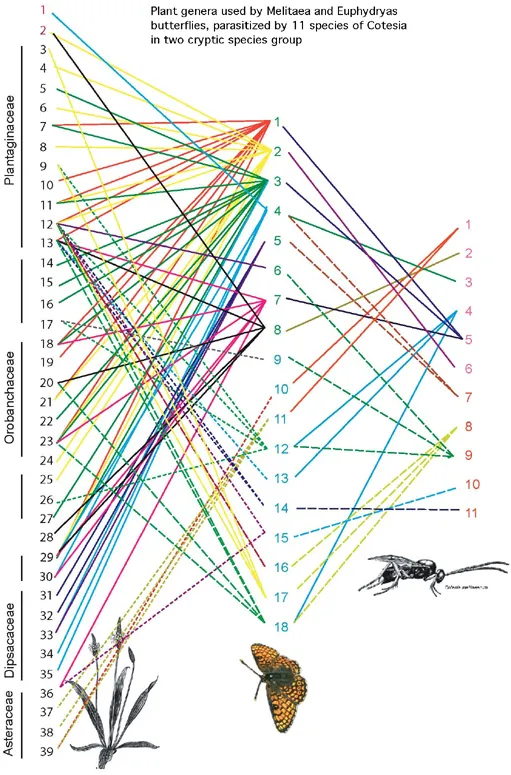Research Topics
Cryptic species groups of parasitoidsCryptic species groups of parasitoids
Parasitoid wasps are good for examining the ecological and evolutionary patterns that spring from close interspecific interaction. We study the phylogenetic pattern of cryptic (sibling) species. That is, groups of closely related species that do not interbreed, but are morphologically and ecologically very similar. Based on molecular and morphological phylogenetic analysis as well as behavioral studies, we have found about 15 species of Cotesia parasitoids exclusively using the checkerspot butterfly genera Melitaea and Euphydryas in Eurasia and North America. Most of the Cotesia fall into two cryptic species groups.
Currently we are examining the potential role of endosymbionts in facilitating the formation of cryptic species in this group of Cotesia:
Valerio, F., C. Martel, C. Stefanescu, S. van Nouhuys, M. Kankare and A. Duplouy (2024). Wolbachia strain diversity in a complex group of sympatric cryptic parasitoid species. BMC Microbiology, 24(1)
Most of this work on the parasitoids was done a while back:
Kankare, M., Stefanescu, C., van Nouhuys, S., Shaw, M. R. 2005. Host specialization by Cotesia wasps (Hymenoptera: Braconidae) parasitising species-rich Melitaeini (Lepidoptera: Nymphalidae) communities in north-eastern Spain. The Biological Journal of the Linnaean Society, 86: 45-65
Kankare, M., van Nouhuys, S. Hanski, I . 2005. Genetic divergence among host-specific cryptic species in Cotesia melitaearum agg., a parasitoid of checkerspot butterflies. Annals of the Entomological Society of America, 98: 382-394

Two radiations of Cotesia on checkerspot hosts
For organisms such as parasitoids, that have strong interactions with their hosts, formation of cryptic species groups may be driven by competitive exclusion. Evidence of this is observation that no Cotesia within a cryptic species group share a host species. Because the ancestors of the two cryptic species groups probably colonized the checkerspot butterflies independently, comparative studies may allow us to get at the process of species group formation.
Mechanisms of co-existence
Two very similar species cannot share a limiting resource, which may explain why we have found no examples of Cotesia from a single cryptic species group using the same host butterfly species. However, there are three examples of two Cotesia species from different cryptic species groups sharing a host butterfly (3 butterfly species out of 18), even in the same locale. This leads us to ask what allows their coexistence. We are conducting laboratory competition experiments using two contrasting species pairs. Their coexistence can differ if the wasps differ in immature aggression, phenology, voltinism, host immune response, and control of host phenology. Additionally, each of the two Cotesia groups is primarily associated with host butterflies feeding on plants with slightly different chemical defense. We will test the hypothesis, using laboratory experiments, that each group is better adapted to hosts sequestering one or the other class of plant defensive chemicals.

